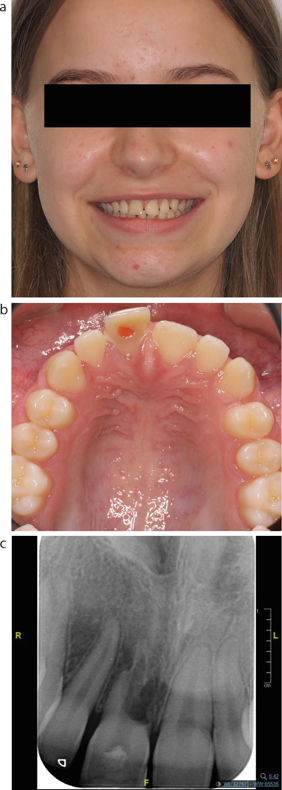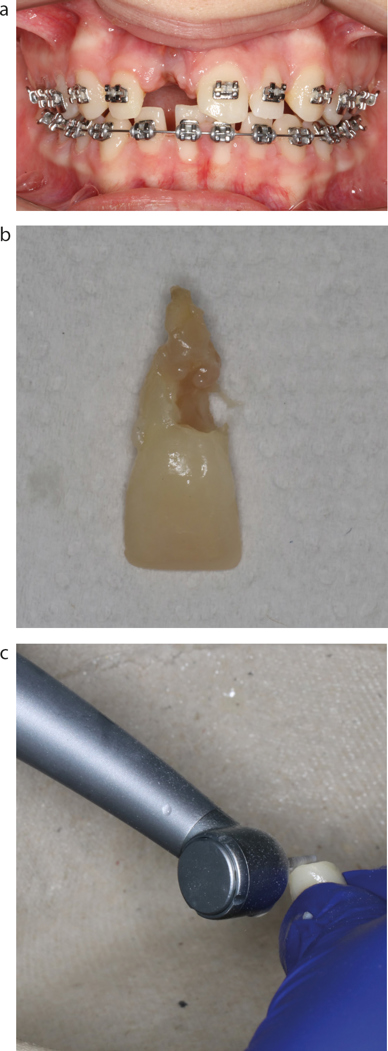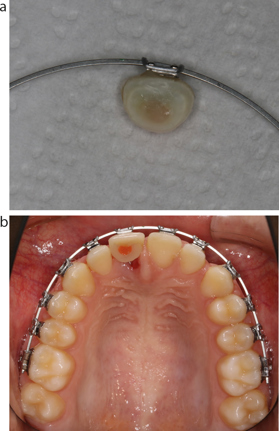Article
Avulsion of permanent teeth represents 0.5−16% of all dental injuries in children,1 with maxillary incisors being the most commonly avulsed tooth. Immediate treatment of choice for an avulsed permanent tooth is usually replantation, which aims to preserve the pulp and the periodontal tissues. However, success of replantation is dependent on the extra-oral dry time, which dictates the survival of the periodontal ligament (PDL) cells. After 30 minutes of extra-oral dry time, most PDL cells are non-viable.2 Replacement resorption is an expected outcome when the extra-oral dry time is over 60 minutes,3 resulting in poor long-term prognosis and eventual extraction of the tooth at a young age. Thus, aesthetic space maintainers are often essential in the interim phase to preserve arch length, as well as aesthetics, until the time is right for a permanent replacement. Traditional methods involve using acrylic teeth as a pontic in either a fixed or removal space maintainer. We present a case, where an alternative technique was used to make a more aesthetic and reliable alternative.
Case report
An 11-year-old patient was referred from a regional dental hospital paediatric department to the orthodontic department at Queen's Medical Centre, Nottingham, with replacement resorption of the UR1 following replantation and extirpation of an avulsed tooth that had an extra-oral dry time of 60 minutes. The patient presented with Class I incisors on a Class I skeletal base, with generalized spacing in the lower and upper labial segments (Figure 1). Treatment was initiated to facilitate replacement of the failing and ankylosed UR1.

An initial treatment plan was made to close the spaces in the dentition using upper and lower fixed appliances, and provide prosthetic replacement of the UR1. Owing to the patient's age, replacement of the UR1 with a resin bonded bridge was planned. The patient did not want to be left without an UR1 for an extended period of time. However, it would not have been possible to close the necessary spacing in the maxilla without extraction of the ankylosed UR1. Treatment commenced and an initial alignment of the teeth with round NiTi wires was gained. Once into an U18/25NiTi wire, the GDP was requested to extract the UR1. To reduce the need for laboratory input to facilitate replacement of the UR1, the GDP was asked to preserve the UR1. In this case, the UR1 was extracted with care, and decoronated by the treating orthodontist (Figure 2). Fit of the UR1 was checked intraorally to ensure no blanching of the tissues occurred when the UR1 was level with the surrounding teeth. The pulp chamber was then sealed with Filtek composite (3M ESPE, USA), and an orthodontic bracket was attached to the labial aspect of the crown. The UR1 crown was then secured to the archwire with the module, to act as a perfect prosthetic and space maintainer (Figures 3 and 4).



The advantages of using fixed space maintainers over removable ones are mainly to do with patient compliance, as patient comfort and speech are sometime detrimentally affected by this appliance. However, in a fixed-space maintainer, the use of the natural tooth as a pontic over those made of polymethyl methacrylate or ‘acrylic’ has its own advantages (Table 1).
Table 1. The advantages of using a natural tooth as a pontic over an acrylic tooth.
| Acrylic | Enamel | |
|---|---|---|
| Bond strength with composite and stainless steel bracket | 6.4MPa4 | 8.9 MPa4 |
| Aesthetics | Near match | Perfect match with better contouring of gingival edge |
In this case, following closure of spaces the patient was seen on a joint clinic with a plan to place a resinretained bridge as a final prosthesis. The patient could in the future opt to have an implant, if desired.
